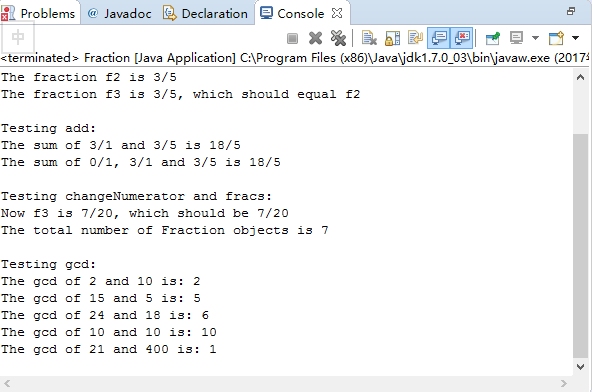修改后的代码:
import java.io.*; /** The Fraction class implements nonnegative fractions (rational numbers). */ public class Fraction { /* private fields within a Fraction. */ private static int numberOfFractions = 0;//change type to static,part 3 private int numerator; private int denominator; /** Constructs a Fraction n/d. * @param n is the numerator. Must be nonnegative. * @param d is the denominator. Must be positive. */ public Fraction(int n, int d) { if (n < 0) { System.out.println("Fatal error: Negative numerator."); System.exit(0); } if (d < 1) { System.out.println("Fatal error: Nonpositive denominator."); System.exit(0); } numberOfFractions++; numerator = n; denominator = d; } /** Constructs a Fraction n/1. * @param n is the numerator. Must be nonnegative. */ public Fraction(int n) { this(n, 1); } /** Constructs a Fraction 0/1. */ public Fraction() { this(0,1);//part1 更改过后的constructor } /** Copies the Fraction "original". */ public int getNumerator(){ return numerator; } public int getDenominator(){ return denominator; } public Fraction(Fraction original) { this(original.getNumerator(),original.getDenominator()); }//part2 修改后的constructor /** Converts this Fraction to a string format: "numerator/denominator." * Fractions should be printed in reduced form (part of your assignment is * to make this true). * @return a String representation of this Fraction. */ public String toString() { int thisGcd = gcd(numerator, denominator); return (numerator / thisGcd + "/" + denominator / thisGcd); } /** Return the sum of two fractions. * @param f2 is the Fraction to be added. * @return the result of adding f2 to this Fraction. */ public Fraction add(Fraction f2) { Fraction r = new Fraction((numerator * f2.denominator) + (f2.numerator * denominator), denominator * f2.denominator); return r; } /** Replaces this Fraction's numerator with a new value. * @param numerator is the new numerator. Must be nonnegative. */ public void changeNumerator(int numerator) { // DO NOT CHANGE THIS SIGNATURE! // Fix the bug that prevents this method from working correctly. if (numerator < 0) { System.out.println("Fatal error: Negative numerator."); System.exit(0); } this. numerator = numerator;//change numerator to this.numerator,part3 } /** Returns the number of Fraction objects in existence. * @return the number of Fraction objects in existence. */ public int fracs() { // DO NOT CHANGE THIS SIGNATURE! // Fix the bug that prevents this method from working correctly. return numberOfFractions; } /** Computes the greatest common divisor (gcd) of the two inputs. * @param x must be nonnegative * @param y must be nonnegative * @return the gcd of x and y */ static private int gcd(int x, int y) { /* Replace the following line with your solution. */ if(y==0) return x; else return gcd(y,x%y); }//part 4,the greatest common divisor of numerator and denominator; /** Put the Fraction class through some tests. * @param argv is not used. */ public static void main(String[] argv) { /* Test all four contructors and toString. */ Fraction f0 = new Fraction(); Fraction f1 = new Fraction(3); Fraction f2 = new Fraction(12, 20); Fraction f3 = new Fraction(f2); System.out.println(" Testing constructors and toString():"); System.out.println("The fraction f0 is " + f0.toString()); System.out.println("The fraction f1 is " + f1); // toString is implicit. System.out.println("The fraction f2 is " + f2); System.out.println("The fraction f3 is " + f3 + ", which should equal f2"); /* Test the add method. */ System.out.println(" Testing add:"); Fraction sumOfTwo = f1.add(f2); // Sum of f1 and f2.part2 Fraction sumOfThree = f0.add(f1).add(f2); // Sum of f0, f1, and f2.part2 System.out.println("The sum of " + f1 + " and " + f2 + " is " + sumOfTwo); System.out.println("The sum of " + f0 + ", " + f1 + " and " + f2 + " is " + sumOfThree); /* Test the methods used in Part III. */ System.out.println(" Testing changeNumerator and fracs:"); f3.changeNumerator(7); System.out.println("Now f3 is " + f3 + ", which should be 7/20"); System.out.println("The total number of Fraction objects is " + f3.fracs()); /* Test gcd function (static method). */ System.out.println(" Testing gcd:"); System.out.println("The gcd of 2 and 10 is: " + gcd(2, 10)); System.out.println("The gcd of 15 and 5 is: " + gcd(15, 5)); System.out.println("The gcd of 24 and 18 is: " + gcd(24, 18)); System.out.println("The gcd of 10 and 10 is: " + gcd(10, 10)); System.out.println("The gcd of 21 and 400 is: " + gcd(21, 400)); } }
主要复习了constructor的应用,this的应用,以及辗转相除法求最大公约数;
运行结果:
